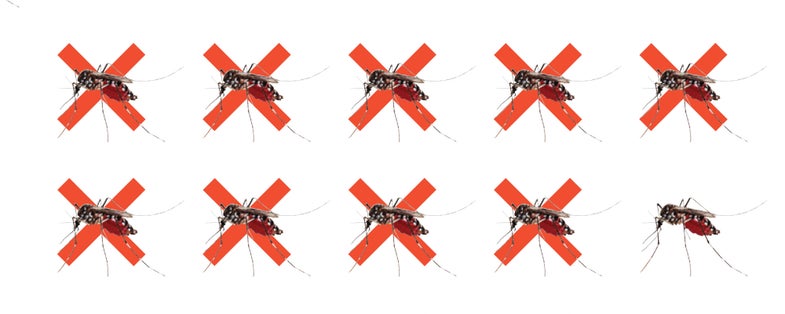These Mosquitoes Are Designed To Self-Destruct
So long pesky insects, and take your pathogens with you

Every year, mosquitoes infect 400 million people with dengue fever, causing severe headaches and joint pain. Since a 2009 outbreak in Key West, the Florida Keys Mosquito Control District has spent $1 million a year to try to curb the primary vector: Aedes aegypti. Last July, another mosquito-borne virus reached U.S. shores: chikungunya. Now officials are considering a radical—and highly controversial—approach to control the spread of tropical disease: genetically modified mosquitoes.
What you need to know
1. The Aedes aegypti mosquito thrives in urban settings and is highly resistant to insecticide. Plus it almost exclusively bites people. “It has successfully spread around the world on the back of human transport,” says Andy McKemey of insect-control company Oxitec. “It is the rat of the insect world.”
2. To keep populations in check, Oxitec genetically modified the insects. They injected mosquito eggs with synthetic DNA that codes for a self-limiting gene. This doesn’t kill the mosquitoes outright, but it prevents their offspring from reaching adulthood to mate.
3. “We release sufficient numbers of males to out-compete locals,” McKemey says, “and that gene is passed to their progeny.” Then additional releases of modified moquitoes ensure that the wild populations are diminished enough to no longer pose a threat.
4. Oxitec has conducted trials with its modified mosquito in dengue-ridden regions of Panama, Brazil, Malaysia, and the Cayman Islands. The results show population suppression rates above 90 percent—far greater than the typical 30 percent achieved with insecticides.
5. Oxitec is planning trials for the Keys this year, pending approval from the FDA and a local board. Concerned residents are lobbying to block them, fearing potential unforeseen consequences of releasing the genetically altered insects into the environment.

6. Dengue’s not all. “The chikungunya virus can mutate and is permanently established in the Americas,” says Stephen Higgs, director of the Biosecurity Research Institute at Kansas State University. More than 2,300 travelers brought the disease to the United States in 2014, and Florida counts 11 locally transmitted cases. “We don’t know what it’ll do next, but it could become widely distributed in the U.S.,” Higgs says.
7. Wiping out the mosquitoes isn’t a perfect solution, though. “Even if it is effective, this technique has shown it can reduce mosquito populations, not disease,” says Durland Fish, an epidemiologist at Yale University. These viruses can be wily. “It is not one and done.”
This article was originally published in the July 2015 issue of Popular Science, under the title “Mosquitoes Designed To Self-Destruct.”